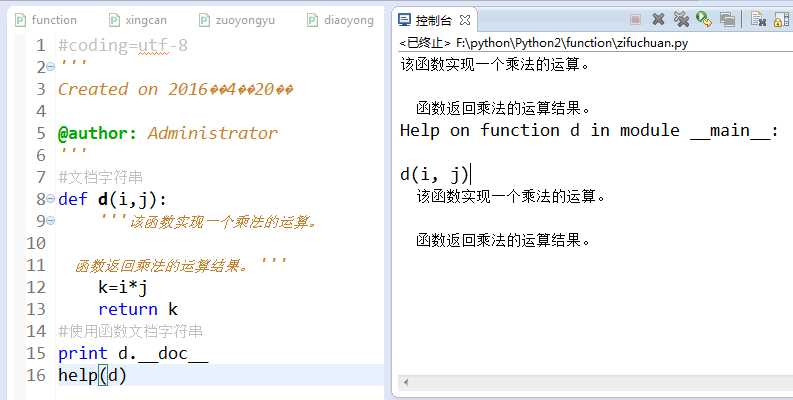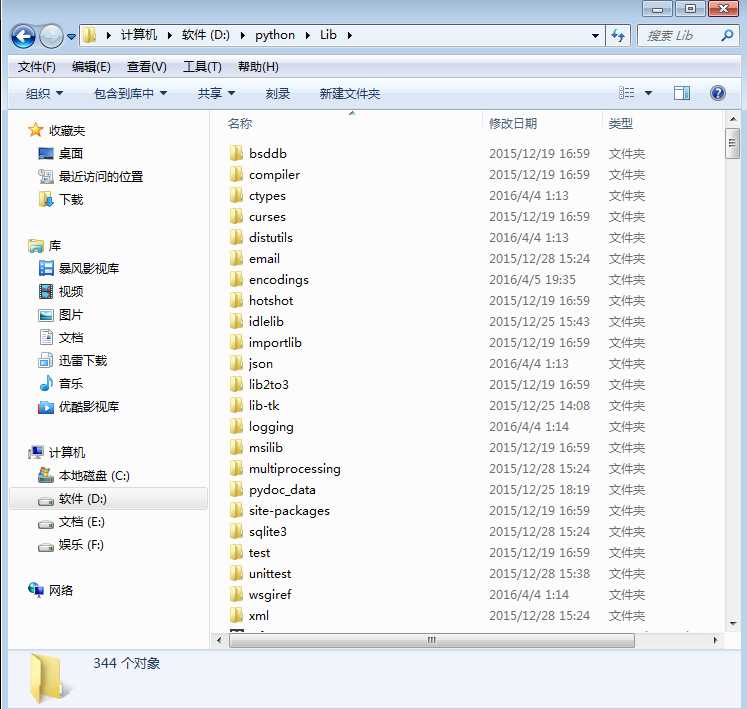标签:
一、python函数
1.认识函数
函数分为系统函数与自定义函数。
1 #coding=utf-8 2 ‘‘‘ 3 Created on 2016年4月19日 4 5 @author: Administrator 6 ‘‘‘ 7 #函数的功能 8 #系统函数 9 #1.取字符串长度 10 ‘‘‘ 11 a="hello world python!" 12 print len(a) 13 #2.字符串切割 14 a="student" 15 b=a.split("u") 16 print b 17 ‘‘‘ 18 #3.自定义函数 19 ‘‘‘ 20 def a(): 21 print "hello" 22 print 777 23 a() 24 ‘‘‘ 25 def function1(): 26 a=8 27 print a 28 function1()
2.形参与实参
1 #coding=utf-8 2 ‘‘‘ 3 Created on 2016??4??19?? 4 5 @author: Administrator 6 ‘‘‘ 7 #函数的形参与实参 8 #形参 9 ‘‘‘ 10 def function1(a,b): 11 if a>b: 12 print a 13 else: 14 print b 15 16 ‘‘‘ 17 #实参 18 #function1(1,3) 19 #参数的传递 20 #简单的参数传递 21 ‘‘‘ 22 def function2(a,b): 23 if a>b: 24 print "前面的数大于后面的数" 25 else: 26 print "后面的数大于前面的数" 27 function2(7,8) 28 ‘‘‘ 29 #赋值传递 30 ‘‘‘ 31 def function3(a,b=8): 32 print a 33 print b 34 function3(1) 35 function3(1,2) 36 ‘‘‘ 37 #关键参数 38 def function4(a=1,b=2,c=3):#初始化 39 print a 40 print b 41 print c 42 function4(2) 43 function4(b=7,c=8) 44 function4(5,b=8,c=9) 45 function4(b=2,c=1,a=0) 46 #注意参数不能冲突 47 #function4(b=2,c=9,6) 48
3.全局变量与局部变量
1 #coding=utf-8 2 ‘‘‘ 3 Created on 2016??4??20?? 4 5 @author: Administrator 6 ‘‘‘ 7 #全局变量与局部变量 8 #局部变量 9 ‘‘‘ 10 def func2(a): 11 i=7 12 print i 13 i=9 14 func2(i) 15 print i 16 ‘‘‘ 17 #全局变量,i在函数外也起作用,但并不是全都一样 18 def func3(): 19 global i 20 i=7 21 print i 22 #global i 23 i=9 24 func3() 25 print i 26 i=9 27 print i
4.函数的使用与返回值
1 #coding=utf-8 2 ‘‘‘ 3 Created on 2016??4??20?? 4 5 @author: Administrator 6 ‘‘‘ 7 #函数的使用与返回值 8 #函数的调用 9 ‘‘‘ 10 def a(): 11 i=1 12 print i 13 a() 14 ‘‘‘ 15 #函数返回值 16 #一个返回值 17 ‘‘‘ 18 def test(): 19 i=7 20 return i 21 print test() 22 ‘‘‘ 23 #多个返回值,元组的形式存储多个返回值 24 def test2(i,j): 25 k=i*j 26 return i,j,k 27 x=test2(2,5) 28 print x 29 y,z,m=test2(2, 5) 30 print y 31 print m
5.文档字符串
文档字符串作用:解决函数杂乱问题。
文档字符串的使用方法:
1.为每个函数加文档说明
2.编写文档字符串
第一行写函数功能
第二行空开。
第三行写具体功能。
句子末尾使用句号,英文首字母大写。
1 #coding=utf-8 2 ‘‘‘ 3 Created on 2016??4??20?? 4 5 @author: Administrator 6 ‘‘‘ 7 #文档字符串 8 def d(i,j): 9 ‘‘‘该函数实现一个乘法的运算。 10 11 函数返回乘法的运算结果。 ‘‘‘ 12 k=i*j 13 return k 14 #使用函数文档字符串 15 print d.__doc__ 16 help(d)
以上代码运行结果如下:

二、python模块
1.认识python模块
函数实现一项或多项功能的一段程序。
模块是函数功能的拓展,实现一项或多项功能的程序块。封装了许多功能。
模块里可以重用多个函数。
进入python安装目录,lib下,很多文件夹都是模块。
自定义模块也放在lib下。
模块的文件目录如下图所示:

1 #coding=utf-8 2 ‘‘‘ 3 Created on 2016??4??20?? 4 5 @author: Administrator 6 ‘‘‘ 7 #导入模块 8 ‘‘‘ 9 import math 10 print math.pi 11 ‘‘‘ 12 #sys模块 13 import sys 14 #查看版本信息 15 print sys.version 16 #查看目录地址 17 print sys.executable 18 #返回windows版本信息 19 print sys.getwindowsversion() 20 #查到导入的模块 21 print sys.modules.keys()
2.字节编译
执行Python模块的两种方式:1.先将模块里的内容编译成二进制语言,然后执行二进制语言2.直
接执行对应模块的二进制语言程序。第二种执行速度快一些。
密会编译成二进制语言程序的过程叫做字节编译,产生一个与编译模块对应的.pyc文件。.pyc文
件是经过编译后的模块对应的二进制文件。
字节编译不是编译。
import的同时若果没有.pyc文件会自动生成.pyc文件。
cmd 下编译生成.pyc文件 : python -m compileall 模块名
pyc文件使用二进制文件查看器可以查看。Binary Viewer
.pyc文件可以用于反编译
3.from...import语句
import只是导入模块,没有导入某个属性或方法。
导入功能可以使用from...import语句。
from...import*;导入模块的所有方法。
1 #coding=utf-8 2 ‘‘‘ 3 Created on 2016??4??20?? 4 5 @author: Administrator 6 ‘‘‘ 7 #第一种 8 ‘‘‘ 9 import sys 10 print sys.version 11 ‘‘‘ 12 #第二种 ,直接调用version方法 13 ‘‘‘ 14 from sys import version 15 print version 16 ‘‘‘ 17 #第三种方法 18 from sys import * 19 print version 20 print executable
4.认识__name__属性
主函数:调用了其他函数。
主模块:调用了其他模块的模块。
一个模块可是主模块也可以是非主模块。
__name__ 属性可以判断是不是主模块
1 #coding=utf-8 2 ‘‘‘ 3 Created on 2016??4??20?? 4 5 @author: Administrator 6 ‘‘‘ 7 #name属性的使用 8 9 #print __name__ 10 #name???? 11 if __name__=="__main__": 12 print "It‘s main" 13 else: 14 print "It‘s not main" 15 16 #print __name__
5.自定义模块
自定义模块分为系统自带模块,不要要定义;自定义模块。
自定义模块在lib下定义。
模块定义是变量最好初始化,或者声明参数类型,防止语法错误。
6.dir()函数
dir()查看指定功能的模块列表。
dir()查看指定列表功能。
1 #coding=utf-8 2 ‘‘‘ 3 Created on 2016??4??20?? 4 5 @author: Administrator 6 ‘‘‘ 7 #dir()查看指定功能的模块列表。 8 ‘‘‘ 9 import sys 10 print dir(sys) 11 print sys.dllhandle 12 ‘‘‘ 13 #dir()查看指定列表功能。属性方法的列表,没有数据。 14 ‘‘‘ 15 d=[] 16 print dir(d) 17 ‘‘‘ 18 c=["a","b"] 19 print dir(c) 20 e=() 21 print dir(e)
以上代码运行结果如下:

2016-04-20 22:57:15
标签:
原文地址:http://www.cnblogs.com/chance88/p/5414848.html